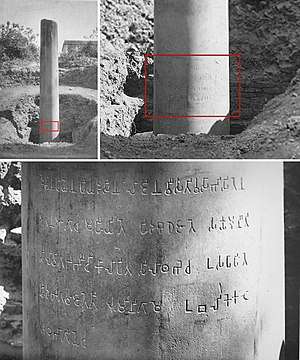Lumbini pillar inscription
The Lumbini pillar inscription, also called the Paderia inscription, is an inscription in the ancient Brahmi script, discovered in December 1896 on a pillar of Ashoka in Lumbini, modern Nepal by Alois Anton Führer.[1] Another famous inscription discovered nearby in a similar context is the Nigali-Sagar inscription. The Lumbini inscription is generally categorized among the Minor Pillar Edicts of Ashoka, although it is in the past tense and in the ordinary third person (not the royal third person), suggesting that it is not a pronouncement of Ashoka himself, but a rather later commemoration of his visit in the area.[2]
| Lumbini pillar inscription | |
|---|---|
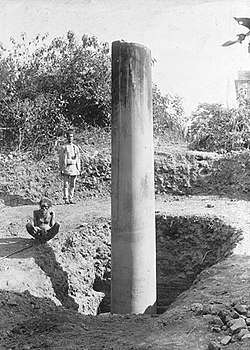 Excavation of the pillar, and discovery of the inscription at the bottom of the pillar. | |
| Material | Polished sandstone |
| Size | Height: Width: |
| Period/culture | 3rd century BCE |
| Discovered | 27.469650°N 83.275595°E |
| Place | Lumbini, Nepal. |
| Present location | Lumbini, Nepal. |
 Lumbini pillar 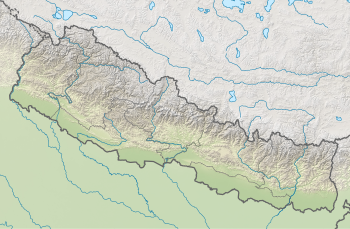 Lumbini pillar | |
Discovery of the pillar
Ancient historical records of the Buddhist monuments of the region, made by the ancient Chinese monk-pilgrim Xuanzang in the 7th century CE and by another ancient Chinese monk-pilgrim Faxian in the early 5th century CE, had been used in an effort to search for the place of birth of the Buddha, said to be in Lumbini, and his ancient city of Kapilavastu. The Lumbini pillar itself, set up where the Buddha was born, was mentioned by Xuanzang, who said that it was surmounted by the sculpture of a horse and that it had been broken in half, but he never mentioned the presence of an inscription, which, according to Vincent A. Smith, may already have been hidden by the time he visited in the 7th century.[1] The description by Xuanzang adds that the pillar was split in two and fallen on the ground at the time he saw it.[3]
.jpg)
The pillar was supported underground by a brick base, which according to Vincent A. Smith had to be of a comparatively more recent date. He suggested that the fallen pillar had been re-erected at the time of the Buddhist Pala dynasty, in the 11th or 12th century.[4]
The existence of the stone pillar itself was already known before the discovery: it had already been reported to Vincent A. Smith by a local landowner named Duncan Ricketts, around twelve years before (circa 1884). Rubbings of the Medieval inscriptions on top of the pillar had been sent by Ricketts, but they were thought of no great consequence.[5] Führer has also heard about the pillar in 1895, while he was investigating the nearby Nigali-Sagar pillar.[5]
Discovery of the inscription (1896)
In December 1896, Alois Anton Führer was making a follow-up survey of the nearby Nigali-Sagar pillar, discovered and investigated by him the previous year, in March 1895.[6][1]
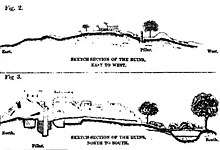
According to some accounts, Fuhrer found the Lumbini pillar on December 1st, and then asked the help of local commander, General Khadga Samsher Rana, to excavate it.[8][9] According to other accounts General Khadga Samsher Rana knew the location of the pillar and led Führer to it.[10] Reportedly, Fuhrer was not present when the inscription was discovered, as he arrived only "a little later", but Ricketts was witness to it.[1] Initially, only the top of the pillar was visible, with a Medieval inscription on it. The Nepalese authorities dug around the pillar, to find the ancient Brahmi inscription, which therefore had remained underground, hidden from view.[11][1]
The Brahmi inscription on the pillar gives evidence that Ashoka, emperor of the Maurya Empire, visited the place in 3rd-century BCE and identified it as the birth-place of the Buddha. The inscription was translated by Paranavitana:[12][note 1]
| Translation (English) | Transliteration (original Brahmi script) | Inscription (Prakrit in the Brahmi script) |
|---|---|---|
|
|
|
Aftermath


Following the discovery of the pillar, Führer relied on the accounts of ancient Chinese pilgrims to search for Kapilavastu, which he thought had to be in Tilaurakot. Unable to find anything significant, he started excavating some structures at Sagarwa, which he said were stupas of the Shakyas, and was in the process of faking pre-Mauryan inscriptions on bricks, when he was caught in the act by Vincent Arthur Smith.[20][21]
Soon after, Alois Anton Führer was exposed as "a forger and dealer in fake antiquities", and had to resign from his position in 1898.[6] Führer's early archaeological successes had apparently encouraged him to inflate his later discoveries to the point of creating forgeries.[22] Vincent Arthur Smith further revealed in 1901 the blunt truth about Führer's Nepalese discoveries, saying of Führer's description of the archaeological remains at Nigali Sagar that "every word of it is false", and characterizing several of Führer's epigraphic discoveries in the area, including the inscriptions at the alleged Shakya stupas at Sagarwa, as "impudent forgeries".[23][24] However Smith never challenged the authenticity of the Lumbini pillar inscription and the Nigali Sagar inscription.[25]
Führer had written in 1897 a monograph on his discoveries in Nigali Sagar and Lumbini, Monograph on Buddha Sakyamuni's birth-place in the Nepalese tarai[26] which was withdrawn from circulation.[27]
Issues of authenticity
Although generally accepted as genuine, this inscription does raise a few issues in terms of authenticity:
- The Lumbini inscription is in the third person, written by someone reporting a past visit of Devanampriya Priyadarsi, and is not written in Devanampriya Priyadarsi's own name contrary to all known edicts.[28][6] So, by its own internal evidence, it may have been written at any time in history after the ruler's visit.[29] In effect, ancient Brahmi was still understood until the beginning of 4th century CE before being rediscovered in the 19th century.[30]
- The qualifier used for the Buddha in the inscription is Sakyamuni (𑀲𑀓𑁆𑀬𑀫𑀼𑀦𑀺), which is normally a Sanskritized form of the Prakrit Sakamuni (𑀲𑀓𑀫𑀼𑀦𑀺 "Sage of the Sakas), although the fully Sanskritized form would be Śakyamuni (𑀰𑀓𑁆𑀬𑀫𑀼𑀦𑀺, pronounced "Shakyamuni").[28][31] The problem is that the rest of the inscription is entirely in Prakrit, and Sanskrit inscriptions are not otherwise attested before the 1st century BCE-1st century CE.[28] "Sakyamuni" first appears in the Lumbini inscription, the other known forms being "Sakiya" in the Piprahwa inscription, "Sakka" in the Pali literature, "Sakka" and "Śakka" in Prakrit literature, "Saka" (Bharhut) and "Śaka" in the epigraphic record.[32]
- The Buddha is never mentioned in the Major Pillar Edicts nor in the Major Rock Edicts, and only appears once in the Bairat Temple inscription.[29]
- The inscription was discovered by Alois Anton Führer, who is also known to have forged Brahmi inscriptions on ancient stone artefacts, so there is a possibility that he is the actual author of the inscription.[6][33] The engraving is in extremely good condition and seems fresh: when Rhys Davids made a copy of the inscription in 1900, he noted that it was "almost as if freshly cut".[34][35] Following re-examination fifty years later, academics commented: "The pillar bears an inscription of Asoka, very well preserved. The lines are straight and letters very tastefully written. It appears as if the inscription has been very recently incised."[36]
On these grounds, Christopher I. Beckwith considers the Lumbini inscription as a later work, posterior to the 1st century CE at least,[28] and there is also a possibility that Führer himself is the actual author of the inscription.[6]
This issue was popularized in 2008 by British writer Charles Allen.[37][6]
The Nigali Sagar inscription, in many ways similar and located a few kilometers from Lumbini, also falls under the same kind of suspicion.[38]
Gallery
| Wikimedia Commons has media related to Ashoka pillar (Lumbini). |
 The pillar of Ashoka.
The pillar of Ashoka..jpg) The Ashoka inscription on the pillar today.
The Ashoka inscription on the pillar today. Rubbing of the inscription.
Rubbing of the inscription.
 Luṃmini Gāme (𑀮𑀼𑀁𑀫𑀺𑀦𑀺𑀕𑀸𑀫𑁂, "City of Lumbini") inscription in the Rummindei Edict of Ashoka.
Luṃmini Gāme (𑀮𑀼𑀁𑀫𑀺𑀦𑀺𑀕𑀸𑀫𑁂, "City of Lumbini") inscription in the Rummindei Edict of Ashoka.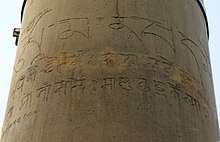 Lumbini pillar Medieval inscription of king Ripumalla, 13-14th century CE.
Lumbini pillar Medieval inscription of king Ripumalla, 13-14th century CE.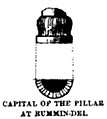 Lumbini pillar capital.[39]
Lumbini pillar capital.[39] View of the ruins and the Lumbini pillar from the South
View of the ruins and the Lumbini pillar from the South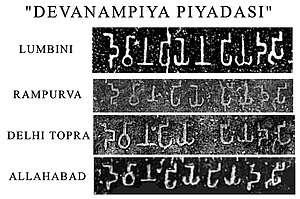 Various "Devanampiya Piyadasi" inscriptions on the Pillars of Ashoka.
Various "Devanampiya Piyadasi" inscriptions on the Pillars of Ashoka.
References
- Smith, Vincent A. (1897). "The Birthplace of Gautama Buddha". The Journal of the Royal Asiatic Society of Great Britain and Ireland: 615–621. JSTOR 25207888.
- Beckwith, Christopher I. (2017). Greek Buddha: Pyrrho's Encounter with Early Buddhism in Central Asia. Princeton University Press. p. 246. ISBN 978-0-691-17632-1.
- Mukherji, P. C.; Smith, Vincent Arthur (1901). A report on a tour of exploration of the antiquities in the Tarai, Nepal the region of Kapilavastu;. Calcutta, Office of the superintendent of government printing, India. p. 6.
- Mukherji, P. C.; Smith, Vincent Arthur (1901). A report on a tour of exploration of the antiquities in the Tarai, Nepal the region of Kapilavastu;. Calcutta, Office of the superintendent of government printing, India. p. 7.
- Smith, Vincent A. (1897). "The Birthplace of Gautama Buddha". The Journal of the Royal Asiatic Society of Great Britain and Ireland: 617. JSTOR 25207888.
- Beckwith, Christopher I. (2017). Greek Buddha: Pyrrho's Encounter with Early Buddhism in Central Asia. Princeton University Press. pp. 234–235. ISBN 978-0-691-17632-1.
- Mukherji, P. C.; Smith, Vincent Arthur (1901). A report on a tour of exploration of the antiquities in the Tarai, Nepal the region of Kapilavastu;. Calcutta, Office of the superintendent of government printing, India. p. Plate XIII.
- Falk, Harry. The discovery of Lumbinī. p. 13.
- Barth, A. (1897). "Le Journal des savans". Gallica (Académie des inscriptions et belles–lettres): 72.
- Falk, Harry. The discovery of Lumbinī. p. 13.
- Weise, Kai (2013). The Sacred Garden of Lumbini: Perceptions of Buddha's birthplace. UNESCO. ISBN 978-92-3-001208-3.
- Paranavitana, S. (Apr. - Jun., 1962). Rupandehi Pillar Inscription of Asoka, Journal of the American Oriental Society, 82 (2), 163-167
- Weise, Kai; et al. (2013), The Sacred Garden of Lumbini – Perceptions of Buddha's Birthplace (PDF), Paris: UNESCO, pp. 47–48, archived from the original (PDF) on 2014-08-30
- Hultzsch, E. /1925). Inscriptions of Asoka. Oxford: Clarendon Press, pp. 164-165
- Tsukamoto, Keisho (2006). [http://echo-lab.ddo.jp/Libraries/印度学仏教学研究/印度學佛教學研究第54巻第3号/Vol.54%20,%20No.3(2006)200塚本%20啓祥「ルンミンデーイーのアショーカ法勅再考%20-マヤ堂出土の「自然石」に関連して-」.pdf Reconsidering the Rummindei Pillar Edict of Asoka: In Connection with 'a piece of natural rock' from Mayadevi Temple], Journal of Indian and Buddhist Studies 54 (3), 1113-1120
- Hultzsch, E. (1925). Inscriptions of Asoka. Oxford: Clarendon Press, pp. 164-165
- Hultzsch, E. (1925). Inscriptions of Asoka. New Edition by E. Hultzsch (in Sanskrit). p. 164.
- British Library Online
- "Dr. Fuhrer went from Nigliva to Rummindei where another Priyadasin lat has been discovered... and an inscription about 3 feet below surface, had been opened by the Nepalese" in Calcutta, Maha Bodhi Society (1921). The Maha-Bodhi. p. 226.
- Dhammika, Shravasti (2008). Middle Land, Middle Way: A Pilgrim's Guide to the Buddha's India. Buddhist Publication Society. p. 41. ISBN 978-955-24-0197-8.
- "Fuhrer's attempt to associate the names of eighteen Sakyas, including Mahanaman, with the structures, on the false claim of writings in pre-Asokan characters, was fortunately foiled in time by V.A. Smith, who paid a surprise visit when the excavation was in progress. The forgery was exposed to the public." in Srivastava, K.M. (1979). "Kapilavastu and Its Precise Location". East and West. 29 (1/4): 65–66..
- Huxley, Andrew (2010). "Dr Führer's Wanderjahre: The Early Career of a Victorian Archaeologist". Journal of the Royal Asiatic Society. 20 (4): 489–503. doi:10.1017/S1356186310000246. ISSN 1356-1863. JSTOR 40926240.
- Mukherji, P. C.; Smith, Vincent Arthur (1901). A report on a tour of exploration of the antiquities in the Tarai, Nepal the region of Kapilavastu;. Calcutta, Office of the superintendent of government printing, India. p. 4.
- Huxley, Andrew (2011). "Mr Houghton and Dr Führer: a scholarly vendetta and its consequences". South East Asia Research. 19 (1): 77. JSTOR 23750866.
- Smith, vincent A. (1914). The Early History Of India Ed. 3rd. p. 169.
- Führer, Alois Anton (1897). Monograph on Buddha Sakyamuni's birth-place in the Nepalese tarai. Allahabad : Govt. Press, N.W.P. and Oudh.
- Thomas, Edward Joseph (2000). The Life of Buddha as Legend and History. Courier Corporation. p. 18. ISBN 978-0-486-41132-3.
- Beckwith, Christopher I. (2017). Greek Buddha: Pyrrho's Encounter with Early Buddhism in Central Asia. Princeton University Press. p. 168. ISBN 978-0-691-17632-1.
- Beckwith, Christopher I. (2017). Greek Buddha: Pyrrho's Encounter with Early Buddhism in Central Asia. Princeton University Press. p. 245–246. ISBN 978-0-691-17632-1.
- Beckwith, Christopher I. (2017). Greek Buddha: Pyrrho's Encounter with Early Buddhism in Central Asia. Princeton University Press. p. 242. ISBN 978-0-691-17632-1.
- On Śakyamuni being a Sanskritization: Stephan Baums "We even have the spellings Śakimuni and Śakyamuna, though you may wish to consider the latter a Sanskritization." quoted in Bronkhorst, Johannes (2016). How the Brahmins Won: Appendix X Was there Buddhism in Gandhāra at the Time of Alexander?. Brill. pp. 483–489, page 6 of the apendix.
- Fleet, J. F. (1906). "The Inscription on the Piprawa Vase". The Journal of the Royal Asiatic Society of Great Britain and Ireland: 161. JSTOR 25210223.
- Thomas, Edward J. (2002). History of Buddhist Thought. Courier Corporation. p. 155, note 1. ISBN 978-0-486-42104-9.
- Rhys Davids, Thomas William (1915). Encyclopaedia Of Religion And Ethics Vol.8. p. 196.
- Beckwith, Christopher I. (2017). Greek Buddha: Pyrrho's Encounter with Early Buddhism in Central Asia. Princeton University Press. p. 235 note 34. ISBN 978-0-691-17632-1.
- Nalinaksha, Dutta; Bajpai, Krishna D. (1956). Development of Buddhism in Uttar Pradesh. Publication Bureau, Government of Uttar Pradesh. p. 330.
- Allen, Charles (2008). The Buddha and Dr. Führer: an archaeological scandal. London: Haus. ISBN 9781905791934.
- Thomas, Edward J. (2002). History of Buddhist Thought. Courier Corporation. p. 155, note 1. ISBN 978-0-486-42104-9.
- Mukherji, P. C.; Smith, Vincent Arthur (1901). A report on a tour of exploration of the antiquities in the Tarai, Nepal the region of Kapilavastu;. Calcutta, Office of the superintendent of government printing, India. p. 34.
| Edicts of Ashoka (Ruled 269–232 BCE) | |||||
| Regnal years of Ashoka |
Type of Edict (and location of the inscriptions) |
Geographical location | |||
| Year 8 | End of the Kalinga war and conversion to the "Dharma" |  Udegolam Nittur Brahmagiri Jatinga Rajula Mandagiri Yerragudi Sasaram Barabar Kandahar (Greek and Aramaic) Kandahar Khalsi Ai Khanoum (Greek city) | |||
| Year 10[1] | Minor Rock Edicts | Related events: Visit to the Bodhi tree in Bodh Gaya Construction of the Mahabodhi Temple and Diamond throne in Bodh Gaya Predication throughout India. Dissenssions in the Sangha Third Buddhist Council In Indian language: Sohgaura inscription Erection of the Pillars of Ashoka | |||
| Kandahar Bilingual Rock Inscription (in Greek and Aramaic, Kandahar) | |||||
| Minor Rock Edicts in Aramaic: Laghman Inscription, Taxila inscription | |||||
| Year 11 and later | Minor Rock Edicts (n°1, n°2 and n°3) (Panguraria, Maski, Palkigundu and Gavimath, Bahapur/Srinivaspuri, Bairat, Ahraura, Gujarra, Sasaram, Rajula Mandagiri, Yerragudi, Udegolam, Nittur, Brahmagiri, Siddapur, Jatinga-Rameshwara) | ||||
| Year 12 and later[1] | Barabar Caves inscriptions | Major Rock Edicts | |||
| Minor Pillar Edicts | Major Rock Edicts in Greek: Edicts n°12-13 (Kandahar) Major Rock Edicts in Indian language: Edicts No.1 ~ No.14 (in Kharoshthi script: Shahbazgarhi, Mansehra Edicts (in Brahmi script: Kalsi, Girnar, Sopara, Sannati, Yerragudi, Delhi Edicts) Major Rock Edicts 1-10, 14, Separate Edicts 1&2: (Dhauli, Jaugada) | ||||
| Schism Edict, Queen's Edict (Sarnath Sanchi Allahabad) Lumbini inscription, Nigali Sagar inscription | |||||
| Year 26, 27 and later[1] |
Major Pillar Edicts | ||||
| In Indian language: Major Pillar Edicts No.1 ~ No.7 (Allahabad pillar Delhi pillar Topra Kalan Rampurva Lauria Nandangarh Lauriya-Araraj Amaravati) Derived inscriptions in Aramaic, on rock: | |||||
